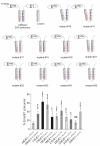The Erns Carboxyterminus: Much More Than a Membrane Anchor
- PMID: 34201636
- PMCID: PMC8310223
- DOI: 10.3390/v13071203
The Erns Carboxyterminus: Much More Than a Membrane Anchor
Abstract
Pestiviruses express the unique essential envelope protein Erns, which exhibits RNase activity, is attached to membranes by a long amphipathic helix, and is partially secreted from infected cells. The RNase activity of Erns is directly connected with pestivirus virulence. Formation of homodimers and secretion of the protein are hypothesized to be important for its role as a virulence factor, which impairs the host's innate immune response to pestivirus infection. The unusual membrane anchor of Erns raises questions with regard to proteolytic processing of the viral polyprotein at the Erns carboxy-terminus. Moreover, the membrane anchor is crucial for establishing the critical equilibrium between retention and secretion and ensures intracellular accumulation of the protein at the site of virus budding so that it is available to serve both as structural component of the virion and factor controlling host immune reactions. In the present manuscript, we summarize published as well as new data on the molecular features of Erns including aspects of its interplay with the other two envelope proteins with a special focus on the biochemistry of the Erns membrane anchor.
Keywords: ER retention; RNA virus polyprotein processing; amphipathic helix; charge zipper; extracellular vesicles; membrane anchor; pestivirus; secreted T2 RNase; signal peptidase; transport of virus particles; virus assembly; virus budding.
Conflict of interest statement
The authors declare that they have no conflicts of interest.
Figures














Similar articles
-
Charged Residues in the Membrane Anchor of the Pestiviral Erns Protein Are Important for Processing and Secretion of Erns and Recovery of Infectious Viruses.Viruses. 2021 Mar 10;13(3):444. doi: 10.3390/v13030444. Viruses. 2021. PMID: 33801849 Free PMC article.
-
Downstream Sequences Control the Processing of the Pestivirus Erns-E1 Precursor.J Virol. 2020 Dec 9;95(1):e01905-20. doi: 10.1128/JVI.01905-20. Print 2020 Dec 9. J Virol. 2020. PMID: 33028718 Free PMC article.
-
A new type of intracellular retention signal identified in a pestivirus structural glycoprotein.FASEB J. 2012 Aug;26(8):3292-305. doi: 10.1096/fj.12-207191. Epub 2012 May 1. FASEB J. 2012. PMID: 22549508
-
Structures and Functions of Pestivirus Glycoproteins: Not Simply Surface Matters.Viruses. 2015 Jun 29;7(7):3506-29. doi: 10.3390/v7072783. Viruses. 2015. PMID: 26131960 Free PMC article. Review.
-
What can pestiviral endonucleases teach us about innate immunotolerance?Cytokine Growth Factor Rev. 2016 Jun;29:53-62. doi: 10.1016/j.cytogfr.2016.03.003. Epub 2016 Mar 17. Cytokine Growth Factor Rev. 2016. PMID: 27021825 Free PMC article. Review.
Cited by
-
Positively Charged Amino Acids in the Pestiviral Erns Control Cell Entry, Endoribonuclease Activity and Innate Immune Evasion.Viruses. 2021 Aug 10;13(8):1581. doi: 10.3390/v13081581. Viruses. 2021. PMID: 34452446 Free PMC article.
-
Fifty Shades of Erns: Innate Immune Evasion by the Viral Endonucleases of All Pestivirus Species.Viruses. 2022 Jan 27;14(2):265. doi: 10.3390/v14020265. Viruses. 2022. PMID: 35215858 Free PMC article.
-
Current progress on innate immune evasion mediated by Npro protein of pestiviruses.Front Immunol. 2023 Apr 5;14:1136051. doi: 10.3389/fimmu.2023.1136051. eCollection 2023. Front Immunol. 2023. PMID: 37090696 Free PMC article. Review.
-
The Molecular Basis for Erns Dimerization in Classical Swine Fever Virus.Viruses. 2021 Nov 2;13(11):2204. doi: 10.3390/v13112204. Viruses. 2021. PMID: 34835010 Free PMC article.
References
-
- Lindenbach B.D., Thiel H.J., Rice C.M. Flaviviridae: The Viruses and Their Replication. In: Knipe D.M., Howley P.M., editors. Fields Virology. Volume 5. Lippincott—Raven Publishers; Philadelphia, PA, USA: 2007. pp. 1101–1152.
Publication types
MeSH terms
Substances
LinkOut - more resources
Full Text Sources

